DENVER — Under the spring Colorado sun, crews for Denver Water could be seen doing what they've been for the last three years: Digging deep into streets to replace lead water pipes.
"We're also performing a street cut, digging up the asphalt or concrete in the street," Denver Water's Lead Reduction Program Manager Alexis Woodrow said of the work. "You're doing construction work in the street. You're putting in a connection to the home. But you also have to find them."
Back in 2020, the agency estimated that there was somewhere between 64-84,000 lead service lines in the Denver region. Since then, they've received more funding to continue their efforts to replace them within 15 years.
"We also want to look at where replacement of that service line has the greatest impact," Woodrow said.
Lead has been a nationwide issue, especially in pipes, over concerns that it enters drinking water and have health impacts.
By the end of May, nearly all daycare providers and public schools in Colorado will have to test their water for lead because of a 2022 state law that requires it.
This week, the EPA released their water infrastructure needs survey, which looks at water-related needs as a whole but includes the issue of lead service lines.
According to the survey, there are an estimated 111,907 lead service lines in Colorado.
Figuring out what areas in the state are impacted the most by lead service lines is the next level of research.


Data driving intervention
DU professor and researcher Dr. Julia Roncoroni explained the part her team played in research for The Color of Water In Colorado Project at the University of Denver.
She leads the health disparities research team.
"No amount of lead in your blood is safe," she said.
That knowledge helped propel her passion for the project and her team.
While research is still underway, she shared findings from her team's "systematic review" of existing data and mapped out the overlap of several social determinants of health, which included lead in water pipes.
"And what we found using data from 2020 is that several children, around 1.5% of children in Colorado ... had elevated blood lead levels," she explained.
She says they found that several areas populated mainly by communities of color and low-income communities were among those most impacted by lead in the water.
Using Commerce City as an example, she attributed some of their early findings to the way the city grew.
"Beginning in 1996, Commerce City started dividing in some ways - to grow north. And so you had buildings of large residential housing complexes and golf courses and related infrastructure," she explained. "But the LatinX and Lower SES community members stayed in the older higher density housing stocks in areas that were that are highly industrialized where the water is really polluted ... we found that in those areas, lead is higher."
She says the next steps are more robust data collections to identify points of areas where intervention is needed.
"But I think before we can think of intervention in that way, we have to start thinking of, you know, capturing the issue more more broadly," she said.


A statewide effort
Woodrow with Denver Water says that in the last three years, they've replaced more than 15,000 lead service lines.
Their goal was to replace 4,500 each year, so they're ahead of schedule. She adds that they have projects ongoing in Denver's underserved communities.
"And so that's when we're really focusing on our underserved communities, disproportionately impacted communities, looking at income and other environmental stress factors," Woodrow said. "So obviously areas where there is large concentrations of small children, but other vulnerable communities as well."
Ron Falco, the Drinking Water Program manager for the state's health department, says there has been a recent emphasis in better understanding the inventory of lead service lines in the state.
"So, what we're going to see with this inventory is likely that lead service lines are more concentrated in older areas in the communities that have them," Falco said. "We also believe that based on kind of initial understanding of what kind of infrastructure water systems have is that many, many water systems do not have lead service lines at all, which is good news."
CDPHE has also developed a website to make sure the required entities understand their requirements for testing their water.
SUGGESTED VIDEOS: Next with Kyle Clark

